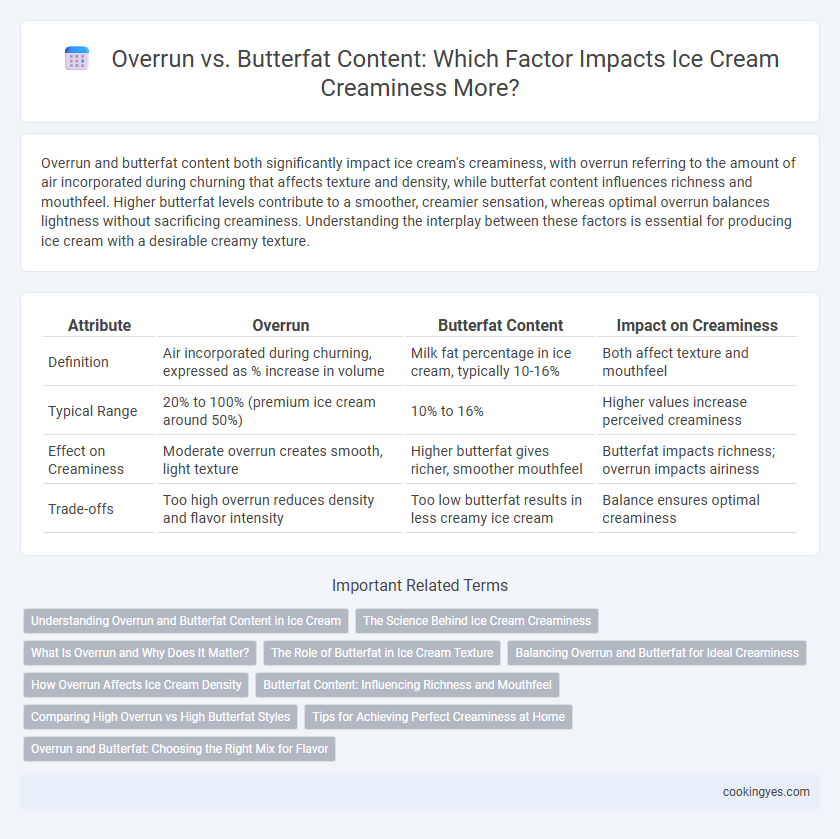Overrun and butterfat content both significantly impact ice cream's creaminess, with overrun referring to the amount of air incorporated during churning that affects texture and density, while butterfat content influences richness and mouthfeel. Higher butterfat levels contribute to a smoother, creamier sensation, whereas optimal overrun balances lightness without sacrificing creaminess. Understanding the interplay between these factors is essential for producing ice cream with a desirable creamy texture.
Table of Comparison
| Attribute | Overrun | Butterfat Content | Impact on Creaminess |
|---|---|---|---|
| Definition | Air incorporated during churning, expressed as % increase in volume | Milk fat percentage in ice cream, typically 10-16% | Both affect texture and mouthfeel |
| Typical Range | 20% to 100% (premium ice cream around 50%) | 10% to 16% | Higher values increase perceived creaminess |
| Effect on Creaminess | Moderate overrun creates smooth, light texture | Higher butterfat gives richer, smoother mouthfeel | Butterfat impacts richness; overrun impacts airiness |
| Trade-offs | Too high overrun reduces density and flavor intensity | Too low butterfat results in less creamy ice cream | Balance ensures optimal creaminess |
Understanding Overrun and Butterfat Content in Ice Cream
Overrun, the amount of air incorporated during freezing, significantly affects ice cream's volume and texture, with higher overrun leading to lighter, fluffier products. Butterfat content, derived from cream, directly influences the richness and creaminess, as higher butterfat percentages provide a smoother, more indulgent mouthfeel. Balancing overrun and butterfat content is essential to achieve the desired creaminess without compromising texture or flavor intensity.
The Science Behind Ice Cream Creaminess
Ice cream creaminess is primarily influenced by the balance between overrun and butterfat content, where overrun refers to the amount of air whipped into the mixture, and butterfat is the fat derived from milk or cream. High butterfat content contributes to a rich, smooth texture by coating ice crystals, while controlled overrun enhances lightness without sacrificing density. The interaction between air incorporation and fat stabilization determines the final mouthfeel and sensory perception of creaminess in premium ice cream products.
What Is Overrun and Why Does It Matter?
Overrun refers to the amount of air incorporated into ice cream during the freezing process, significantly affecting its texture and volume. Higher overrun results in lighter, fluffy ice cream, while lower overrun produces a denser, creamier product with a richer mouthfeel. Butterfat content complements overrun by providing smoothness and flavor; balancing both is essential to achieve the desired creaminess and quality in premium ice cream.
The Role of Butterfat in Ice Cream Texture
Butterfat plays a crucial role in ice cream texture by providing richness and smoothness, directly influencing creaminess. Higher butterfat content enhances the mouthfeel and helps stabilize air bubbles introduced during overrun, resulting in a denser and creamier product. Balancing butterfat percentage with overrun levels optimizes ice cream's texture, ensuring a premium, indulgent experience.
Balancing Overrun and Butterfat for Ideal Creaminess
Balancing overrun and butterfat content is essential for achieving ideal creaminess in ice cream, where overrun refers to the amount of air incorporated and butterfat determines richness. A moderate overrun, typically between 50-80%, combines with a butterfat content of 10-16% to create a smooth, creamy texture without being overly dense or fluffy. Maintaining this balance ensures optimal mouthfeel, creaminess, and overall sensory experience prized in premium ice cream products.
How Overrun Affects Ice Cream Density
Overrun significantly impacts ice cream density by incorporating air during the freezing process, which increases volume and reduces weight per unit. Higher overrun results in lighter, more aerated ice cream, while lower overrun produces denser, creamier textures. Balancing overrun with butterfat content is essential to achieve the desired creaminess and mouthfeel.
Butterfat Content: Influencing Richness and Mouthfeel
Butterfat content plays a crucial role in determining the richness and mouthfeel of ice cream, with higher percentages contributing to a creamier, more luxurious texture. Typically, premium ice creams contain 14-25% butterfat, enhancing smoothness and flavor retention during consumption. Balancing butterfat with overrun ensures optimal creaminess without compromising the ice cream's structural integrity and sensory appeal.
Comparing High Overrun vs High Butterfat Styles
High overrun in ice cream increases volume by incorporating more air, resulting in a lighter, fluffier texture with lower butterfat content, which produces a less rich mouthfeel. High butterfat content, typically above 14%, delivers a denser, creamier texture with a richer taste but lower volume due to less air incorporation. Balancing overrun and butterfat content is crucial for achieving a desirable creaminess, with premium ice creams often combining moderate overrun with high butterfat for optimal richness and smoothness.
Tips for Achieving Perfect Creaminess at Home
Achieving perfect creaminess in homemade ice cream depends on balancing overrun and butterfat content, with higher butterfat levels around 14-16% yielding richer, smoother texture. Maintaining moderate overrun, typically 20-50%, prevents excessive air incorporation that can make ice cream icy or fluffy rather than creamy. Using full-fat cream, ensuring proper churning speed, and controlling freezing temperature are key tips to maximize creaminess and enhance mouthfeel.
Overrun and Butterfat: Choosing the Right Mix for Flavor
Overrun, the amount of air incorporated into ice cream, directly affects its texture and creaminess, with higher overrun leading to lighter, fluffier ice cream while lower overrun results in denser, richer consistency. Butterfat content, typically ranging from 10% to 16% in premium ice cream, contributes to smoothness and enhances flavor depth by providing a creamy mouthfeel. Balancing overrun and butterfat is essential for achieving the desired texture and flavor profile, ensuring a harmonious mix that delivers both creaminess and rich taste.
Overrun vs Butterfat Content for Creaminess Infographic

 cookingyes.com
cookingyes.com